 |
An early 1960s Volkswagen Beetle is framed by other metal items in the junkyard off the Red Trail on Oct. 31, 2009. |
Having items dumped on public property is a common problem and West Rock has certainly endured its share of unwanted trash. Springside and Wintergreen Avenues along the park’s southwestern border are locations where people commonly dump household items like furniture. The New Haven Public Works Department is responsive to complaints filed on the See, Click, Fix website and hauls away the junk in a timely manner. As quickly as the workers remove items, others are dumped, so it is a never-ending battle.
This page focuses on the former junkyard off the Red Trail and the resulting clean-up by volunteers. The area of about half an acre is located to the west of the Red Trail where it is a gravel road, 0.25 miles north of the green gate on Mountain Road, located at the turn in the road between 660 and 670 Mountain Road.
Dumped items along West Shepard Avenue and Baldwin Drive are covered by a page that I created on March 31, 2025, as that narrative grew long enough to warrant its own page on this website:
These are all good examples of an answer to the question, “How do you tackle a big project?” Answer: A little bit at a time and over time the project gets completed.
Red Trail Junk Pile North of Mountain Road
I started volunteering at West Rock in 2007 and my first choice of projects was reblazing the Red Trail, including blazing the section north of Mountain Road, which had no trail blazes at the time. I first noticed this junk pile in late 2009 and added it to my West Rock Wish List page on this website. With many priorities to address, ranging from trail blazing to storm damage clearing to invasives cutting, I did nothing about this junk pile for many years.
Finally, in 2022, I found the time to start working on this project off the Red Trail. The first step was getting the approval of the Connecticut State Parks and Forests division to proceed with the clean-up, which we received from then State Parks Director Tom Tyler at a meeting of the West Rock Ridge Advisory Council. This approval is required because anything more than 50 years old could be considered a historical site, requiring an archeological survey, and the items in this area dated back 50 or more years.
This junk pile is located on a small portion of a 55-acre parcel the state purchased on Aug. 13, 1976, as it was assembling parcels of land to create West Rock Ridge State Park. The roughly rectangular shaped property extends north from Mountain Road toward Baldwin Drive.
 |
Truck parts and other assorted metal items litter the woods of the Red Trail on Oct. 31, 2009. |
 |
Hot water heaters point toward the Volkswagen Beetle off the Red Trail on Oct. 31, 2009. |
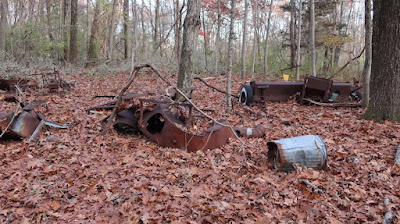 |
A metal “octopus” designed to distribute air and a metal spreading tool are among the items dumped in the woods off the Red Trail, as seen on Oct. 31, 2009. |
 |
The back of a tanker truck is the largest item dumped in the woods off the Red Trail, as seen on Oct. 31, 2009. |
 |
A metal spreader and other metal items are visible near the Red Trail, as seen on Oct. 31, 2009. |
As told to me by neighbors and dog walkers and visible on older aerial photos, the property was used as an orchard as evidenced by the lines of trees in those photos. The current gravel road from the green gate has existed for a long time as part of that orchard. With the change in ownership, the road connection was shifted east around the existing homes to join Mountain Road at the curve. When it was privately owned, the road intersected Mountain Road between the two houses west of the gate.
The orchard owner allowed a heating contractor to dump items at the back edge of the orchard. The evidence is clear because much of what volunteers have been removing has been this type of equipment, including eight furnaces, eight hot water heaters, 21 furnace motors, 20 smaller electric motors, and 12 transformers. Other items that are not from a heating business include seven 50-gallon metal drums and the tanker part of an oil truck used for delivering oil to homes.
Someone was using the area for bulky waste because we have also found a refrigerator, an oven, two washing machines, a pool liner, gutters, a Volkswagen Beetle, 67 car and truck tires, and parts of a truck that has too little remaining for easy identification. We also found eight twin mattress sized metal bedframes with the wire mesh to support a mattress. In addition, we found a cache of glass windowpanes buried near the oil tanker that filled 15 five-gallon sized plastic buckets.
They were also dumping household trash as under the soil was bottles and cans, carpeting, carpet padding, latex paint, a garden hose, a toilet, and more. As of April 20, 2024, volunteers filled 109 shopping bags and 31 plastic buckets (the 5-gallon size) full of this household trash for proper off-site disposal. The glass panes mentioned above are included in this figure.
 |
Metal items were arranged in the woods off the Red Trail north of Mountain Road in November 2022 after some were piled there by volunteers from others parts of the site. |
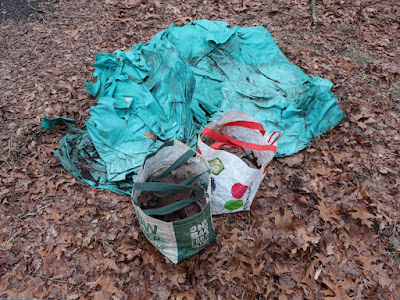 |
A pool liner was among the trash dug out of the ground in the junkyard area off the Red Trail, as seen on Jan. 29, 2023. |
|
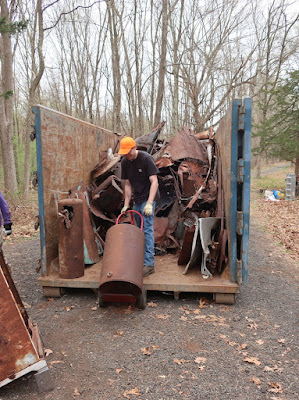 |
A volunteer loads a metal item into the dumpster on April 15, 2023. |
 |
A backhoe prepares to dump a hot water heater into the dumpster on April 15, 2023. The back hoe loaded a few remaining items into the top of the dumpster after it was filled by volunteers who did most of the loading by hand. |
 |
The entire metal pile and some additional items fit into this 40-yard dumpster, as seen on Saturday, April 15, 2023. |
 |
The pile of 60 tires, along with bags of fiberglass insulation from inside hot water heaters and a refrigerator, awaited collection from state workers, as seen on April 15, 2023, and were removed on May 16, 2023. |
 |
This wooded area once full of metal items has been almost completely cleared of them, as seen on April 15, 2023. |
Red Trail Junkyard Cleanup Timeline
I started on my own in January 2022 by gathering small items that I could take out for disposal and piling up larger items for a future collection: one pile for metal items, one pile for tires, and one pile for any trash I could not remove in a particular visit. I did nothing on this project for most of 2022 as I worked on other priorities, including reblazing the Regicides and Sanford Feeder Trails, and doing the seasonal pruning back of all trails. I resumed my collection in later December 2022, again piling larger items and taking home the household items for disposal.
We had work events with multiple volunteers to pull items out of the ground and consolidate them in the center of the site. These took place on Feb. 19 and Dec. 17, 2022. I made trips on almost a weekly basis for anywhere between half an hour to two hours at a time from January to March 2023, typically going there after leading a hike at West Rock or a nearby area. I scheduled these hikes for the exact purpose of putting me in the area to work on this project.
Other volunteers began joining me for these post-hike Sunday collections in March 2023. We then moved the items from the woods about 100 to 150 feet over to the side of the trail on March 25 and April 2, 2023. Adding to the challenge of moving them, we had two bursts of hail during the morning on March 25 and some rain toward the end of our collection in the afternoon.
On April 15, 2023, volunteers had more fun than doing taxes by loading up a dumpster with all the metal items we had moved to the side of the trail, plus half a dozen larger ones from the pile that had remained in the woods. One volunteer who lived nearby used his backhoe to crunch down the items, allowing us to get all the collected metal items into the dumpster. Through Sept. 2023, a total of 10,880 pounds of metal had been removed from the site.
 |
Volunteers began the second phase of the Red Trail junkyard cleanup in November 2023, gathering the remaining junk items into this pile in the woods near the trail. |
Phase II of the Cleanup
This project is now about 98 percent complete. The cleanup resumed in November 2023 after the danger of disturbing a yellow jacket nest and getting stung has passed. We also waited out the peak tick season. The first task required cutting and pulling the invasive plants that had grown over the summer, including barberry and winged euonymus, along with clearing a patch of non-native forsythia. We also had to rake the leaves that were hiding the trash. Another job was cutting up and moving out of the way many fallen branches.
In a series of clean up days from November 2023 to April 2024, the focus shifted to the lower slope of the area at the back where volunteers pushed and rolled the hot water heaters and furnaces to a temporary staging area in the woods. They also dug furnace motors and household trash out of the ground. As they pull up things sticking from the ground, they find even more household trash.
Four volunteers moved the metal pile from the woods to the side of the Red Trail on Saturday, April 13, 2024 with tremendous help from five Quinnpiac University students who are part of the men's ice hockey club. The students moved many large metal objects, including a wide metal farm spreader, which one of the regular volunteers had cut into smaller pieces.
 |
A Quinnipiac University student moves a hot water heater from the woods to the side of the Red Trail on April 13, 2024. |
 |
Quinnipiac University students and adult volunteers move metal items from the woods to the side of the Red Trail on April 13, 2024. |
 |
Quinnipiac University students pose in front of the metal pile along the side of the Red Trail on April 13, 2024. |
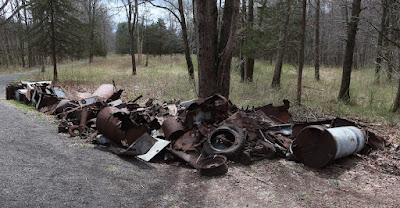 |
The metal pile along the side of the Red Trail on April 13, 2024 was loaded into a dumpster on April 20, 2024. |
I met the driver from Sims Metal on April 19, 2024, and he dropped off a 40-yard dumpster. On that day, I pulled up assorted pieces of metal and trash that were just below the surface, putting the metal in the dumpster and removing the trash.
Volunteers returned on Saturday, April 20, 2024 to load up the dumpster. The major task was moving the tanker part of an oil truck that was moved by the same volunteer with the same backhoe from 2023. With all that we collected, the dumpster was essentially full. The other task we accomplished that day was removing the last of what we could remove of the glass panes buried in the ground near the tanker.
Through April 2024, a total of 18,300 pounds of metal has been removed from the site. Instead of gradually rusting away over many decades, this steel is being recycled into new products.
This project was quite labor intensive and took a great deal of time. I spent 100 hours on this project, while other volunteers contributed another 194 hours of service. Truly, this was a team effort.
Looking to the future, the area still needs some more work. There are a few metal objects sticking up out of the ground. Just under the surface broken glass and other trash items can be seen. I plan to return at some point in 2025 (or later) to see what else I can extract. There is no need for another dumpster, as the large items have been hauled out. The area will never been fully cleaned up, but the bulk of it has been removed.
 |
A driver drops off a 40-yard dumpster on April 19, 2024. |
 |
A volunteer in a backhoe lifts the oil tank truck back on April 20, 2024. |
 |
A volunteer in a backhoe places the oil tank truck back into the dumpster on April 20, 2024. |
 |
A hot water heater drops from the backhoe into the dumpster on April 20, 2024. |
 |
The dumpster is nearly filled with metal items taken from the woods, after the last items were loaded on April 20, 2024. |
 |
With all the items loaded into the dumpster, the Red Trail is cleared of metal on April 20, 2024. |
Cleanup Involved Multiple Tasks
Part of the clean-up involved cutting and pulling the various invasive plants that had invaded the area, including Japanese barberry, multi-flora rose, winged euonymus, and Japanese honeysuckle vines, plus forsythia, which does not spread like the invasives, but it is non-native. There were also many downed trees to clear. These shrubs and trees needed to be removed simply to gain access to the trash they were covering.
One task involved taking apart the hot water heaters, removing the fiberglass insulation and bagging that for disposal, taking out the cement that was used at the base, flattening the thin metal skin, and carting out the heavy interior tank. I have also removed the cement from the hot water heaters and broken pieces of concrete block for proper off-site disposal. As of April 2024, the cement took up enough room to fill 19 shopping bags. There are still many more pieces of cement to collect and remove, a project I will likely tackle in December 2024, after a hard freeze that kills any potential yellow jackets that may be nesting in the ground.
Six of the furnaces still had glass vials with mercury inside, used as thermometers. I carefully wrapped them in a paper towel for cushioning and placed them inside a plastic jar with a twist-top lid. I brought them to the Regional Water Authority Haz-Mat collection site at Long Wharf in New Haven in June 2023.
We also carted to the trail the 60 car and truck tires we found. The state removed them in May 2023 at a cost of $438. The other seven tires we found in late 2023 to April 2024, I removed for disposal.
One interesting side project was trying to identify the vintage of the Beetle, which was no easy task because there was no VIN number on the car, the hood, or the engine lid. Further, the tires were all missing, and Beetle looks changed little from year to year. Using online photos as a reference, I determined the car is at least a 1960 model because it has a push button door handle. It can be no later than a 1964 because it has the size of the back side window seen on this model up to 1964. In 1965, the rear window is much larger.
The car probably dates to no later than a 1963 because in 1964 the sunroof became metal and the West Rock car had no sunroof, meaning it may have been cloth that rotted away. The photos I took of the VW model before volunteers dismantled it do not show the interior clearly, which would help to further narrow down the year.





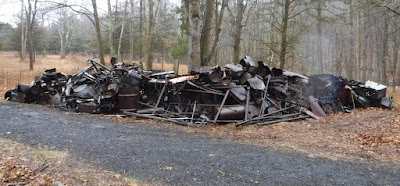
No comments:
Post a Comment